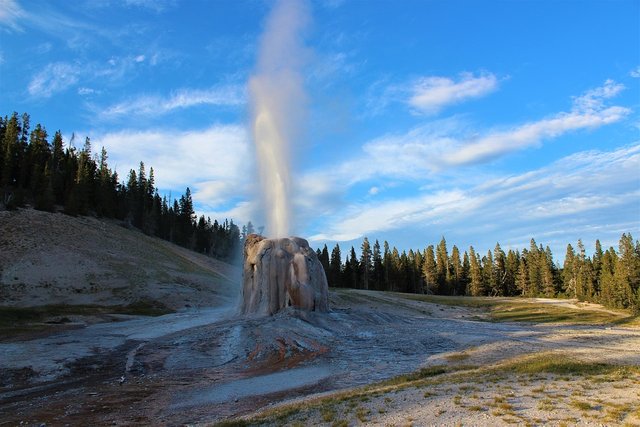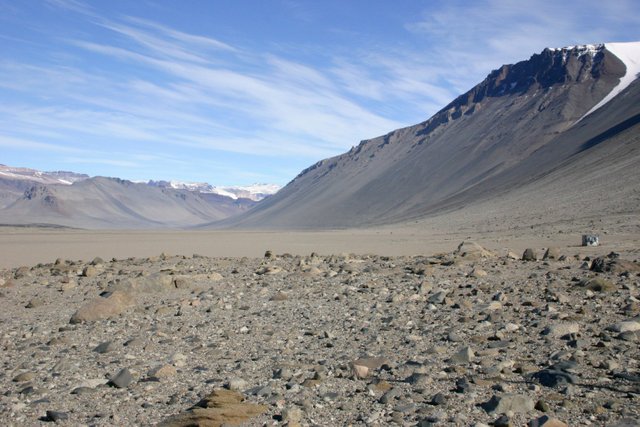The unique Story behind the outstanding Enzyme CALB
Have you ever wondered what Antarctica, our modern Detergents and a Royal Swimming Club could have in common? - Probably not, but if you want to know, then treat yourself to the following story about:
Candida Antarctica Lipase B (CALB)
Antarctica: Lake Vanda at 10 p.m.
Source: Susan A. Romano
Introduction
Let's start with some basic biochemistry:
You may have already heard this statement before, and as far as the material aspects are concerned, this is also perfectly correct. All natural processes that enable life are based on physicochemical interactions and reactions. These are often highly efficient and impressively precisely coordinated.
In the chemical ('substance converting') industry, over 90 % of all products are estimated to be produced by the use of a so-called catalyst. These are substances which advantageously influence a chemical reaction (e.g. by an accelerating effect) and simultaneously are not consumed themselves.
Many reactions actually require a catalyst, otherwise they would only proceed under extreme conditions (e.g. extreme temperature and pressure) or they would merely take place infinitely slow. This applies not only to the chemical industry, but also to the chemical processes of life, and of course also Mother Nature uses biocatalysts, called enzymes.
At this point, we will not dive deep into the chemical structure and functioning of enzymes as catalysts, but focus on the general aspects:
The Power of Biocatalysts
Enzymes are typically very efficient catalysts. Since they can be found in all forms of life, they are considered as environmentally acceptable and also compatible with each other. Normally they act under quite mild conditions. These biocatalysts are not at all bound to their natural role, thus they accept various substrates and catalyze a broad spectrum of reactions.
In the meantime already a significant number of industrial-scale chemical conversions are performed by utilizing biocatalysts!
In addition to their accelerating effects enzymes may also influence the exact reaction pathway, and thus the formation of products with selected properties. This means that enzymes can display following selectivities:
Chemoselectivity
Only a distinct type of functional group within the substrate will be converted.Regioselectivity
If the functional group of interest can be found more than one time in the substrate, enzymes may be able do distinguish between their location and may only convert one of them.Stereoselectivity
When a new stereocenter (a carbon atom with four different residues) is formed during a reaction, biocatalysts may direct the exact spatial arrangement of the four residues, whereas in an uncatalysed process this might happen purely statistically, hence less efficient.
Although some of the properties mentioned here are not straightforward to grasp, it should be relatively clear that enzymes are ingenious tools for chemists to tune their reactions. Of course, the use of biocatalysts also faces some general disadvantages stated in the following summary:
Enzymes...
- ... require narrow, well controlled reaction parameters.
- ... display their highest catalytic activity in water.
- ... are bound to their natural cofactors.
- ... are prone to inhibition phenomena.
- ... may cause allergies.
And this is exactly where the promised story begins:

Source: pixabay
The Search for the Perfect Biocatalyst
Whenever there is something that has both potential and weaknesses, we get creative and try to exploit or even expand the potentials while fixing the vulnerabilities. Nowadays a modern way of doing that with biocatalysts is the application of 'Protein Engineering'. This is an issue with almost never-ending depth, and would by itself be worth a whole series of articles. For now I would like to summarize it as follows:
Known enzymes are modified and then tested whether a desired change can be found. The intended changes may include broader or narrower substrate scope, higher turnover rates or better temperature stability.
Another way to find better biocatalysts is to literally search them. For this, organisms from all over the world can be collected and analyzed for any interesting enzymes. There may even be a kind of a rational guide where to look: Let's say you are looking for enzymes with a particularly high salt tolerance. Then organisms that live in seawater or other salty waters are recommended for investigation, since their enzymes have to be functional under these conditions. Extreme places - such as geysers e.g. - are likely to be sources for biocatalytic discoveries with outstanding properties. But this does not always and necessary have to be the case.
Sometimes unexpected but great findings also happen just by chance.

Source: Wikipedia Commons
In Antarctica, a research station was built at Lake Vanda in the years 1967 to 1969. It was then fully operated until 1991. The scientific work there focused mainly on meteorological, hydrological and seismological investigations. However, also the biology of the nearby lake was investigated, and they found a novel species of yeast, which was named Candida antarctica.
It was found that this yeast produces two enzymes, more specifically two lipases, which are abbreviated CALA and CALB. Lipase A is less extensively characterized than Lipase B and yet enough is known about both enzymes to allow us to conclude, that they both can be considered as exceptional!
They have a tremendous substrate acceptance, considerable turnover rates, relatively broad pH tolerance and a surprisingly high temperature stability. This is surprising because they were isolated from a cold-adapted organism and therefore one would expect high activity at low temperature but at the same time low temperature stability.
For biochemists, this seems almost like a wet dream, because not only do they have a biocatalyst that speeds up a vast number of reactions, but they can also turn up the temperature and make these reactions even faster by that measure without destroying the enzyme.

The typical environment at Wright Valley.
Source: David Saul
Enzymes in Detergents
CALB has been studied extremely well and there are already quite many engineered versions of it. Furthermore it is used on an industrial scale in both chemical synthesis and for the production of detergents. Since our detergents are fed into the sewage system after use, they should be as biocompatible as possible. Therefore, enzymes are nowadays readily used as active substances.
The detergent industry is considered the largest enzyme consuming sector.
Typically, lipases, proteases, amylases and cellulases are used. The first three serve for biocatalytic degradation of all kinds of impurities and thus make them more soluble in water. Cellulases remove the small, superficial clothing lintels that form through mechanical stress and thus ensure that our cotton clothing is lint-free for a longer time.

Source: pixabay
The Royal Lake Vanda Swim Club
The research station at Lake Vanda was especially known for its swimming club. To be honest, there was not so much of swimming involved, it was more of an bad-ass test of courage and a short dip into the ice-cold waters.
Not only the researchers, but also all visitors, and especially less hardened politicians, dignitaries or reporters were faced with this challenge. For this purpose, the Vanda staff assisted in hacking a 'pool' and then the challenged one had to immerse oneself in the cold waters.
But if you wanted to join this 'royal swimming club' and get the highly coveted shoulder patch, you had to follow all given rules. Some of these rules are known and they read as follows:
Rule #1: 'No togs allowed.'
(Socks were allowed, since they kept your feet from sticking to the ice.)
Rule #4: 'Complete immersion must be achieved.'
Rule #6: 'No restriction on photography.'
Rule #10: 'A natural, green fig leaf is allowed to cover nakedness.'
The last rule was obviously a reinforcement of the first one. As you can see in the picture of the Wright Valley: There is nothing growing there and certainly no figs! - Arguably the most important but unwritten Vanda rule was simple and stated:
Maybe I'm just too curious or crazy, but I would like to accept this challenge!
mountain.phil28
References:
- Ole Kirk and Morten Würtz Christensen Lipases from Candida antarctica: Unique Biocatalysts from a Unique Origin Org. Proc. Res. Dev., 2002, 6 (4), pp. 446-451
- Fariha, H. et al. Enzymes used in detergents: Lipases, Afr. J. Biotechnol., 2010, 9 (31), pp. 4836-4844
- Cheng-chih Lai, LIPASE (Triacylglycerol Hydrolase), Homepage, last modified in 1999, accessed 17.04.2018
- Nielsen, T. B. et al. (1999) Lipases A and B from the yeast Candida antarctica. In: Margesin R., Schinner F. (eds) Biotechnological Applications of Cold-Adapted Organisms. Springer, Berlin, Heidelberg
- Michael Parfit, You get to keep your socks on when you go skinny-dipping in Antarctica, VAULT, February 27, 1984
- Pegasus Research Consortium: Antarctica - Lake Vanda, Blog, 1999
- M. Röper, Homogene Katalyse in der Chemischen Industrie, Chem. Unserer Zeit, 2006, 40, 126 – 135.
- Wikipedia Articles: Lake Vanda (accessed 17.04.2018), Vanda Station (accessed 17.04.2018)
Such an amazing post man. Has an industrial use for CALA been found yet ?
I'm now citing a paper from the year 2002, so i don't know how up-to-date this information is but:
So: Yes, in principle. :)
That’s great man :) Amazing post too. Looking forward to more of this from you :)
Thank you very much! I will do what i can. :)
This valley is also called an "Antarctic Oasis" due to the lack of snow. Most of Antarctica is covered by snow and ice!
Quite a lot can be said about the Onyx river and the Vanda lake, just read through the Wikipedia articles, amazing stuff.
Allegedly the Onyx river is Antarctica's longest river (I believe we don't know much about the river systems located under the glaciers, I think there exists much bigger rivers under the ice), it takes melt-water from the glaciers and runs into Lake Vanda. It seems to never freeze, but the water flow is very variable, and sometimes it stops short from going to Lake Vanda.
Lake Vanda is extremely salty, it has three layers that doesn't mix, and the deepest layer is warm! The center of the lake is always covered by clear ice, but at the edges it typically melts once a year.
As far as I understand there is no exit river from Lake Vanda - all the water there either evaporates or disappear into the ground?
That's true there are still some more pretty cool and impressive information on this interesting place on earth out there. :)
No, Lake Vanda does not have an exit, that's also what i know so far. Hence the water will really sink in the ground or evaporate slowly.
A very cool example of how natural selection and evolution can produce some incredible enzymes. Great post!
Thank you @tking77798. Yes, although there was no evolutionary pressure to make the enzyme that thermostable. :)
That's true, the thermostabilility was a coincidence :p
You never know. Probably some thousands of years ago the grand-grand-parents of those microorganisms needed the thermostable feature. Or perhaps even today. Lake Vanda is warm at the bottom, where does the heat come from?
Well done!
Thank you, @roused !
I am interested what more enzymes can do in the nearby future... Mr @mountain.phil28... your CHEMISTRY is AMAZING!
Yes. Chemistry and especially biochemistry is a powerful field ready to be more investigated and for sure a source of more and more fascinating findings. :)
^^ I am glad that I found your post! ^^
Happy to hear so. :)
Great Post!
Thx @rasel49 !
nice <3
Nice work..well done
Thank you very much.